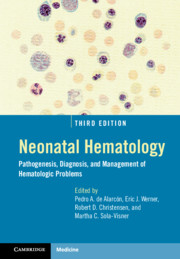Book contents
- Neonatal Hematology
- Neonatal Hematology
- Copyright page
- Contents
- Foreword
- Preface
- Contributors
- Section I Developmental Hematology
- Section II Bone Marrow Failure and Immune Disorders
- Section III Erythrocyte Disorders
- Section IV Platelet Disorders
- Chapter 12 Approach to the Thrombocytopenic Neonate
- Chapter 13 Acquired Thrombocytopenias
- Chapter 14 Fetal and Neonatal Alloimmune Thrombocytopenias
- Chapter 15 Congenital Thrombocytopenias and Thrombocytopathies
- Section V Leucocyte Disorders
- Section VI Hemostatic Disorders
- Section VII Neonatal Transfusion Medicine
- Section VIII Neonatal Oncology
- Section IX Miscellaneous
- Index
- Plate Section (PDF Only)
- References
Chapter 13 - Acquired Thrombocytopenias
from Section IV - Platelet Disorders
Published online by Cambridge University Press: 30 January 2021
- Neonatal Hematology
- Neonatal Hematology
- Copyright page
- Contents
- Foreword
- Preface
- Contributors
- Section I Developmental Hematology
- Section II Bone Marrow Failure and Immune Disorders
- Section III Erythrocyte Disorders
- Section IV Platelet Disorders
- Chapter 12 Approach to the Thrombocytopenic Neonate
- Chapter 13 Acquired Thrombocytopenias
- Chapter 14 Fetal and Neonatal Alloimmune Thrombocytopenias
- Chapter 15 Congenital Thrombocytopenias and Thrombocytopathies
- Section V Leucocyte Disorders
- Section VI Hemostatic Disorders
- Section VII Neonatal Transfusion Medicine
- Section VIII Neonatal Oncology
- Section IX Miscellaneous
- Index
- Plate Section (PDF Only)
- References
Summary
In this chapter, we will focus exclusively on acquired thrombocytopenias that present in the neonatal period. We will discuss the mechanisms underlying some of the most common varieties of neonatal thrombocytopenia, and how the biological differences between neonatal and adult megakaryocytes might contribute to the susceptibility of neonates to develop thrombocytopenia. We will then review the presentation, pathophysiology, and management of the most common etiologies of neonatal early- and late-onset thrombocytopenia, including autoimmune neonatal thrombocytopenia. Alloimmune and congenital causes of neonatal thrombocytopenia will be discussed in detail in Chapters 14 and 15, respectively.
- Type
- Chapter
- Information
- Neonatal HematologyPathogenesis, Diagnosis, and Management of Hematologic Problems, pp. 210 - 222Publisher: Cambridge University PressPrint publication year: 2021

